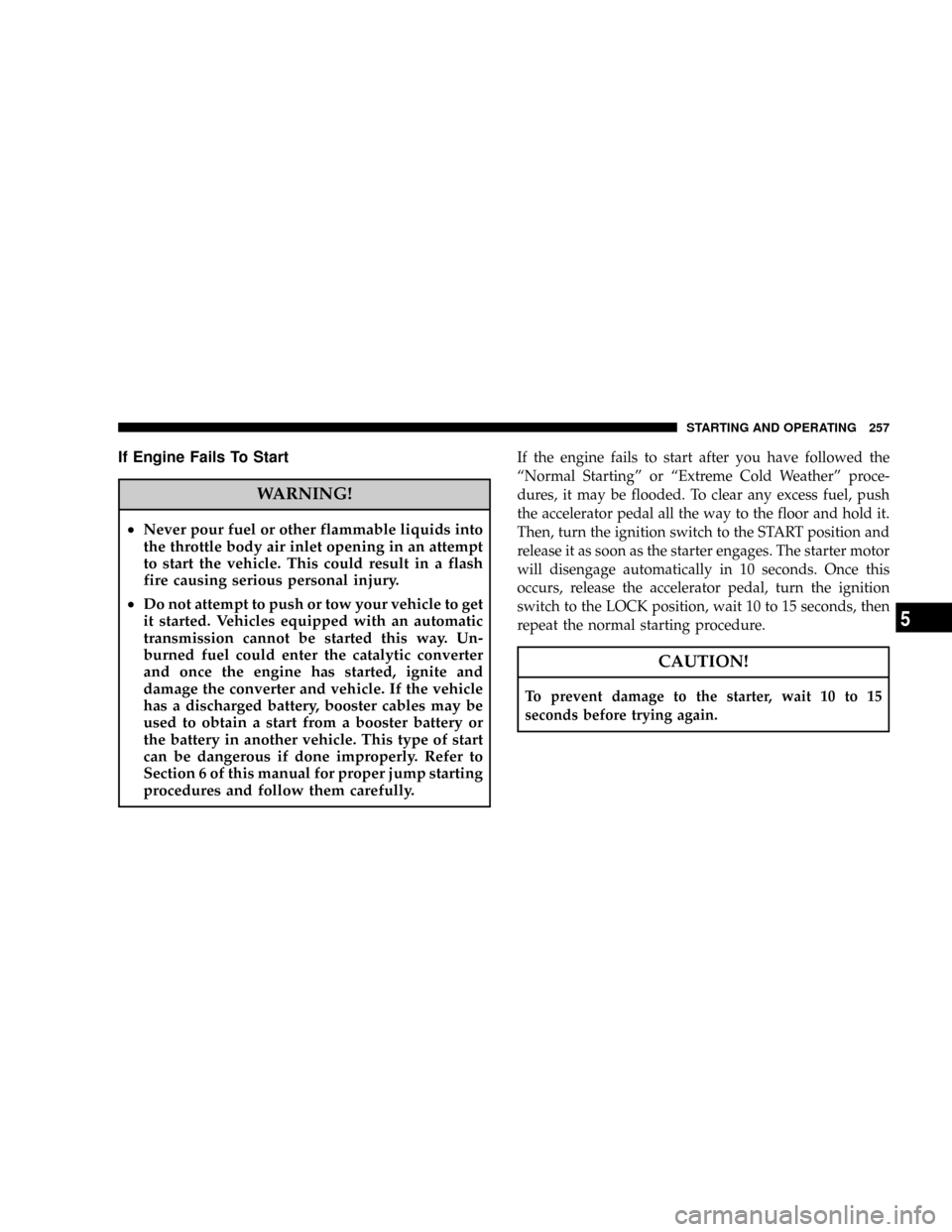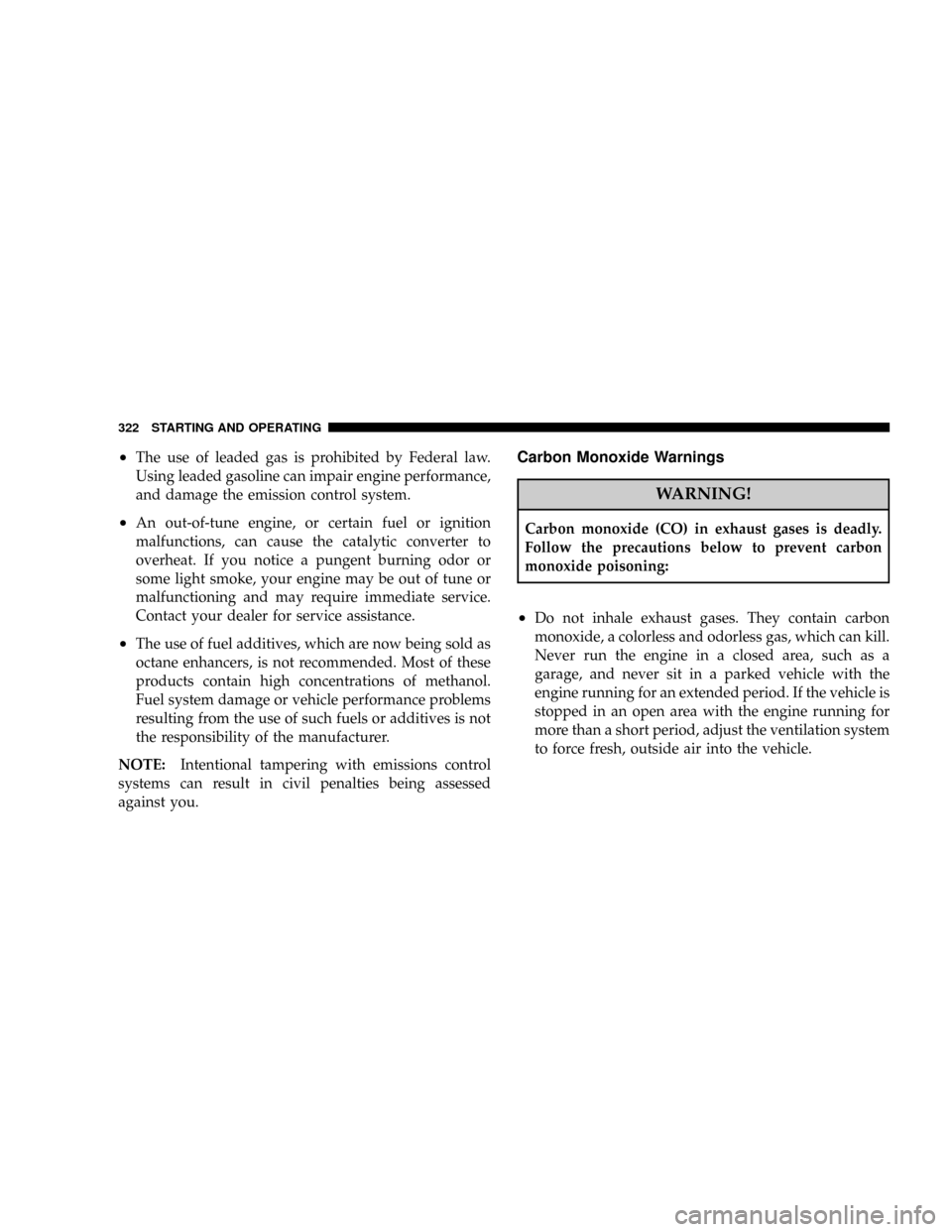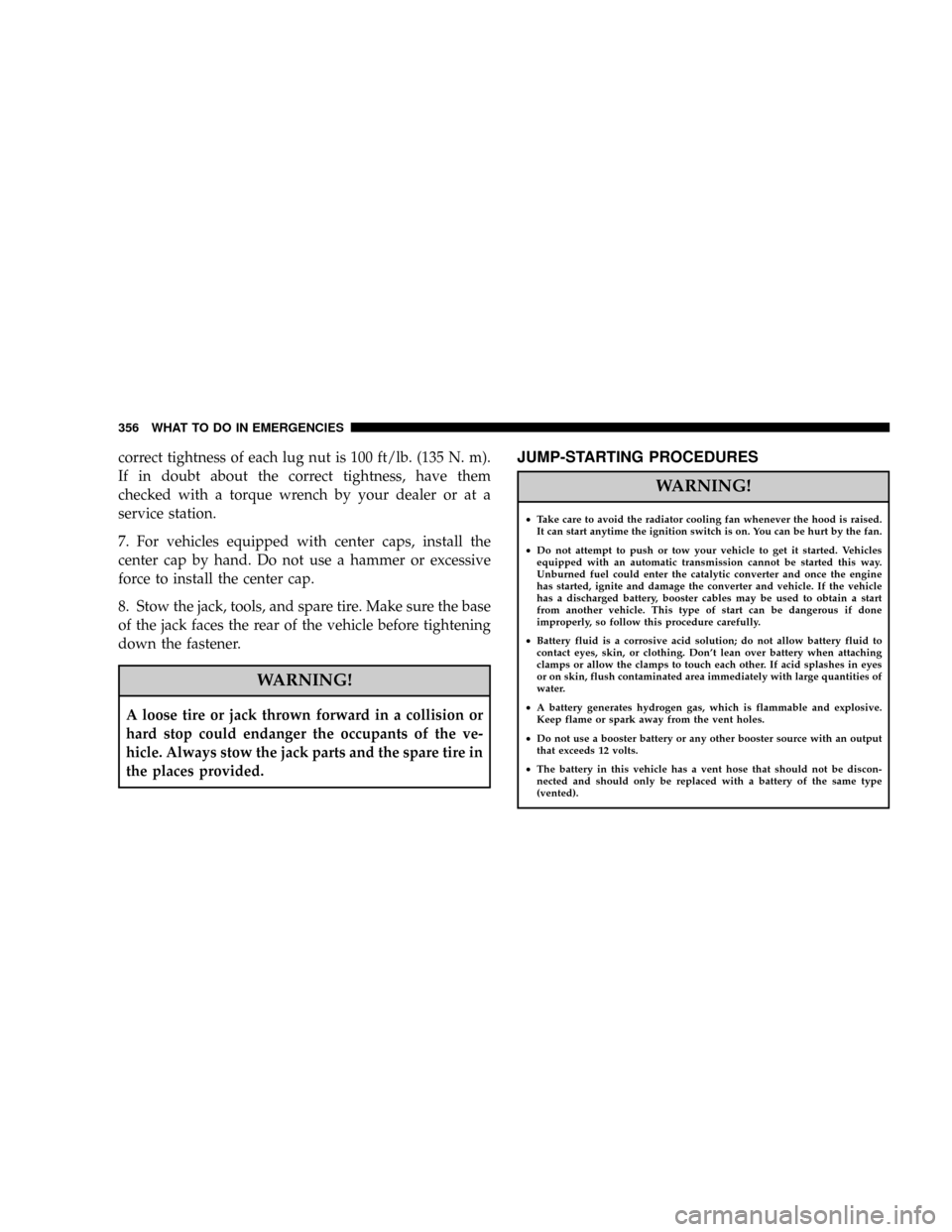2008 DODGE CHARGER catalytic converter
[x] Cancel search: catalytic converterPage 174 of 466

If the ABS light remains on or turns on while driving,
then the Anti-Lock portion of the brake system is not
functioning and service is required. However, the con-
ventional brake system will continue to operate normally
if the BRAKE warning light is not on.
If the ABS light is on, the brake system should be serviced
as soon as possible to restore the benefits of Anti-Lock
brakes. If the ABS light does not turn on when the
Ignition switch is turned to the ON position, have the
light inspected by an authorized dealer. (See page 280 for
more information.)
24. Low Fuel Indicator Light
This light will turn on and a single chime will
sound when the fuel level drops to 1/8 tank. (See
page 323 for more information.)
25. Malfunction Indicator Light
This light is part of an onboard diagnostic system
called OBD. The OBD system monitors engineand automatic transmission control systems. The light
will turn on when the key is in the ON position before
engine start. If the light does not come on when turning
the key from OFF to ON, have the condition checked
promptly.
Certain conditions such as a loose or missing gas cap,
poor fuel quality, etc. may illuminate the light after
engine start. The vehicle should be serviced if the light
stays on through several of your typical driving cycles. In
most situations, the vehicle will drive normally and will
not require towing.
The Malfunction Indicator Light flashes to alert you to
serious conditions that could lead to immediate loss of
power or severe catalytic converter damage. The vehicle
should be serviced as soon as possible if this occurs. (See
page 370 for more information.)
174 UNDERSTANDING YOUR INSTRUMENT PANEL
Page 257 of 466

If Engine Fails To Start
WARNING!
²Never pour fuel or other flammable liquids into
the throttle body air inlet opening in an attempt
to start the vehicle. This could result in a flash
fire causing serious personal injury.
²Do not attempt to push or tow your vehicle to get
it started. Vehicles equipped with an automatic
transmission cannot be started this way. Un-
burned fuel could enter the catalytic converter
and once the engine has started, ignite and
damage the converter and vehicle. If the vehicle
has a discharged battery, booster cables may be
used to obtain a start from a booster battery or
the battery in another vehicle. This type of start
can be dangerous if done improperly. Refer to
Section 6 of this manual for proper jump starting
procedures and follow them carefully.
If the engine fails to start after you have followed the
ªNormal Startingº or ªExtreme Cold Weatherº proce-
dures, it may be flooded. To clear any excess fuel, push
the accelerator pedal all the way to the floor and hold it.
Then, turn the ignition switch to the START position and
release it as soon as the starter engages. The starter motor
will disengage automatically in 10 seconds. Once this
occurs, release the accelerator pedal, turn the ignition
switch to the LOCK position, wait 10 to 15 seconds, then
repeat the normal starting procedure.
CAUTION!
To prevent damage to the starter, wait 10 to 15
seconds before trying again.
STARTING AND OPERATING 257
5
Page 322 of 466

²The use of leaded gas is prohibited by Federal law.
Using leaded gasoline can impair engine performance,
and damage the emission control system.
²An out-of-tune engine, or certain fuel or ignition
malfunctions, can cause the catalytic converter to
overheat. If you notice a pungent burning odor or
some light smoke, your engine may be out of tune or
malfunctioning and may require immediate service.
Contact your dealer for service assistance.
²The use of fuel additives, which are now being sold as
octane enhancers, is not recommended. Most of these
products contain high concentrations of methanol.
Fuel system damage or vehicle performance problems
resulting from the use of such fuels or additives is not
the responsibility of the manufacturer.
NOTE:Intentional tampering with emissions control
systems can result in civil penalties being assessed
against you.
Carbon Monoxide Warnings
WARNING!
Carbon monoxide (CO) in exhaust gases is deadly.
Follow the precautions below to prevent carbon
monoxide poisoning:
²Do not inhale exhaust gases. They contain carbon
monoxide, a colorless and odorless gas, which can kill.
Never run the engine in a closed area, such as a
garage, and never sit in a parked vehicle with the
engine running for an extended period. If the vehicle is
stopped in an open area with the engine running for
more than a short period, adjust the ventilation system
to force fresh, outside air into the vehicle.
322 STARTING AND OPERATING
Page 356 of 466

correct tightness of each lug nut is 100 ft/lb. (135 N. m).
If in doubt about the correct tightness, have them
checked with a torque wrench by your dealer or at a
service station.
7. For vehicles equipped with center caps, install the
center cap by hand. Do not use a hammer or excessive
force to install the center cap.
8. Stow the jack, tools, and spare tire. Make sure the base
of the jack faces the rear of the vehicle before tightening
down the fastener.
WARNING!
A loose tire or jack thrown forward in a collision or
hard stop could endanger the occupants of the ve-
hicle. Always stow the jack parts and the spare tire in
the places provided.
JUMP-STARTING PROCEDURES
WARNING!
²Take care to avoid the radiator cooling fan whenever the hood is raised.
It can start anytime the ignition switch is on. You can be hurt by the fan.
²Do not attempt to push or tow your vehicle to get it started. Vehicles
equipped with an automatic transmission cannot be started this way.
Unburned fuel could enter the catalytic converter and once the engine
has started, ignite and damage the converter and vehicle. If the vehicle
has a discharged battery, booster cables may be used to obtain a start
from another vehicle. This type of start can be dangerous if done
improperly, so follow this procedure carefully.
²Battery fluid is a corrosive acid solution; do not allow battery fluid to
contact eyes, skin, or clothing. Don't lean over battery when attaching
clamps or allow the clamps to touch each other. If acid splashes in eyes
or on skin, flush contaminated area immediately with large quantities of
water.
²A battery generates hydrogen gas, which is flammable and explosive.
Keep flame or spark away from the vent holes.
²Do not use a booster battery or any other booster source with an output
that exceeds 12 volts.
²The battery in this vehicle has a vent hose that should not be discon-
nected and should only be replaced with a battery of the same type
(vented).
356 WHAT TO DO IN EMERGENCIES
Page 363 of 466

MAINTAINING YOUR VEHICLE
CONTENTS
m2.7L Engine Compartment................366
m3.5L Engine Compartment................367
m5.7L Engine Compartment Ð Except Daytona &
R/T ................................368
m5.7L Engine Compartment Ð Daytona & R/T . . . 369
mOnboard Diagnostic System Ð OBD II........370
NLoose Fuel Filler Cap..................370
mEmissions Inspection And Maintenance
Programs............................371
mReplacement Parts......................372mDealer Service.........................373
mMaintenance Procedures..................373
NEngine Oil..........................374
NEngine Oil Filter......................378
NDrive Belts Ð Check Condition And Tension . . 378
NSpark Plugs.........................379
NEngine Air Cleaner Filter................379
NFuel Filter..........................379
NCatalytic Converter....................380
7
Page 380 of 466

Catalytic Converter
The catalytic converter requires the use of unleaded fuel
only. Leaded gasoline will destroy the effectiveness of the
catalyst as an emission control device.
Under normal operating conditions, the catalytic converter
will not require maintenance. However, it is important to
keep the engine properly tuned to assure proper catalyst
operation and prevent possible catalyst damage.
CAUTION!
Damage to the catalytic converter can result if your
vehicle is not kept in proper operating condition. In
the event of engine malfunction, particularly involving
engine misfire or other apparent loss of performance,
have your vehicle serviced promptly. Continued opera-
tion of your vehicle with a severe malfunction could
cause the converter to overheat, resulting in possible
damage to the converter and the vehicle.
NOTE:Intentional tampering with emissions control
systems can result in civil penalties being assessed
against you.
WARNING!
A hot exhaust system can start a fire if you park over
materials that can burn. Such materials might be
grass or leaves coming into contact with your exhaust
system. Do not park or operate your vehicle in areas
where your exhaust system can contact anything that
can burn.
In unusual situations involving grossly malfunctioning
engine operation, a scorching odor may indicate severe
and abnormal catalyst overheating. If this should occur,
safely bring the vehicle to a complete stop, shut the
engine off, and allow the vehicle to cool. Thereafter,
obtain service, including a tune-up to manufacturer's
specifications immediately.
380 MAINTAINING YOUR VEHICLE
Page 446 of 466

B-Pillar Location........................ 294
Brake Assist System...................... 285
Brake Control System, Electronic............. 285
Brake Fluid............................ 423
Brake, Parking.......................... 278
Brake System........................280,394
Anti-Lock (ABS)....................... 280
Fluid Check.......................395,423
Hoses.............................. 394
Master Cylinder....................... 395
Parking............................. 278
Warning Light.....................170,280
Brakes.............................280,394
Brake/Transmission Interlock............... 261
Break-In Recommendations, New Vehicle........ 74
Brightness, Interior Lights.................. 129
Bulb Replacement.....................412,413
Bulbs, Light..........................78,412Calibration, Compass..................... 182
Capacities, Fluid........................ 419
Caps, Filler
Fuel................................ 323
Oil (Engine).......................376,377
Radiator (Coolant Pressure)............... 390
Car Washes............................ 399
Carbon Monoxide Warning...............75,322
Cargo (Vehicle Loading)................... 326
Catalytic Converter...................... 380
CD (Compact Disc) Player...............191,209
Cellular Phone.....................87,209,211
Certification Label....................... 326
Chains, Tire............................ 307
Changing A Flat Tire..................... 346
Chart, Tire Sizing........................ 291
Check Engine Light (Malfunction Indicator
Light)................................ 371
Checking Your Vehicle For Safety............. 75
446 INDEX
Page 447 of 466

Checks, Safety........................... 75
Child Restraint..................65,66,67,70,72
Child Restraint Tether Anchors.............68,70
Child Safety Locks........................ 32
Clean Air Gasoline....................... 320
Cleaning
Wheels............................. 401
Windshield Wiper Blades................. 386
Climate Control......................... 239
Clock........................192,196,211,215
Coin Holder........................... 153
Cold Weather Operation................... 256
Compact Disc (CD) Maintenance............. 238
Compact Spare Tire...................... 302
Compass.............................. 181
Compass Calibration..................... 182
Compass Variance....................... 182
Computer, Trip/Travel.................... 178Connector
UCI ................................ 232
Universal Consumer Interface (UCI)......... 232
Conserving Fuel........................ 178
Console, Floor.......................... 153
Console, Overhead....................... 138
Contract, Service........................ 436
Converter, Catalytic...................... 380
Coolant Pressure Cap (Radiator Cap).......... 390
Cooling System......................... 388
Adding Coolant (Antifreeze).............. 390
Coolant Capacity...................... 419
Coolant Level......................388,391
Disposal of Used Coolant................ 391
Drain, Flush, and Refill.................. 389
Inspection........................... 391
Points to Remember.................... 392
Pressure Cap......................... 390
Radiator Cap......................... 390
INDEX 447
10